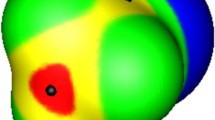Abstract
It has been observed both experimentally and computationally that some divalently-bonded Group VI atoms interact in a noncovalent but highly directional manner with nucleophiles. We show that this can readily be explained in terms of regions of positive electrostatic potential on the outer surfaces of such atoms, these regions being located along the extensions of their existing covalent bonds. These positive regions can interact attractively with the lone pairs of nucleophiles. The existence of such a positive region is attributed to the presence of a “σ-hole.” This term designates the electron-deficient outer lobe of a half-filled p bonding orbital on the Group VI atom. The positive regions become stronger as the electronegativity of the atom decreases and its polarizability increases, and as the groups to which it is covalently bonded become more electron-withdrawing. We demonstrate computationally that the σ-hole concept and the outer regions of positive electrostatic potential account for the existence, directionalities and strengths of the observed noncovalent interactions.

Calculated B3PW91/6-31G** electrostatic potential of F2S, computed on the 0.001 electrons/bohr3 contour of the electronic density. The sulfur atom is toward the reader; the red areas indicate the most positive potentials, reaching +34.4 kcal/mole, along the extensions of the F-S bonds. The purple region (negative) on the left and the one (not totally visible) on the right side of the sulfur are due to its nonbonded s and p electrons. The fluorines (top left and bottom left) also have negative regions of potential (purple areas)


Similar content being viewed by others
References
Rosenfield RE Jr, Parthasarathy R, Dunitz JD (1977) J Am Chem Soc 99:4860–4862
Guru Row TN, Parthasarathy R (1981) J Am Chem Soc 103:477–479
Glusker JP (1998) Topics Curr Chem 198:1–56
Murray-Rust P, Motherwell WDS (1979) J Am Chem Soc 101:4374–4376
Murray-Rust P, Stallings WC, Monti CT, Preston RK, Glusker JP (1983) J Am Chem Soc 105:3206–3214
Ramasubbu N, Parthasarathy R, Murray-Rust P (1986) J Am Chem Soc 108:4308–4314
Auffinger P, Hays FA, Westhof E, Shing Ho P (2004) Proc Nat Acad Sci 101:16789–16794
Metrangolo P, Neukirch H, Pilati T, Resnati G (2005) Acc Chem Res 38:386–395
Politzer P, Lane P, Concha MC, Ma Y, Murray JS (2007) J Mol Mod 13:305–311
Politzer P, Murray JS, Concha MC (2007) J Mol Mod, in press online
Bernard-Houplain MC, Sandorfy C (1973) Can J Chem 51:1075–1082, 3640–3646
Di Paolo T, Sandorfy C (1974) Can J Chem 52:3612–3622
Corradi E, Meille SV, Messina MT, Metrangolo P, Resnati G (2000) Angew Chem Int Ed 39:1782–1786
Brinck T, Murray JS, Politzer P (1992) Int J Quantum Chem, Quantum Biol Symp 19:57–64
Murray JS, Paulsen K, Politzer P (1994) Proc Indian Acad Sci (Chem Sci) 106:267–275
Bader RFW, Carroll MT, Cheeseman JR, Chang C (1987) J Am Chem Soc 109:7968–7979
Lide DR (ed) (2006) Handbook of chemistry and physics, 87th edn. CRC, Boca Raton, FL
Valerio G, Raos G, Meille SV, Metrangolo P, Resnati G (2000) J Phys Chem A 104:1617–1620
Romaniello P, Lelj F (2002) J Phys Chem A 106:9114–9119
Guardigli C, Liantonio R, Mele MI, Metrangolo P, Resnati G, Pilati T (2003) Supramol Chem 15:177–188
Reed AE, Curtiss LA, Weinhold F (1988) Chem Rev 88:899–926
Clark T, Hennemann M, Murray JS, Politzer P (2007) J Mol Mod 13:291–296
Stewart RF (1972) J Chem Phys 57:1664–1668
Politzer P, Truhlar DG (eds) (1981) Chemical applications of atomic and molecular electrostatic potentials. Plenum, New York
Iwaoka M, Komatsu H, KatsudaT, Tomoda S (2002) J Am Chem Soc 124:1902–1909, and papers cited
Cozzolino AF, Vargas-Baca I, Mansour S, Mahmoudkhani AH (2005) J Am Chem Soc 127:3184–3190
Bleiholder C, Werz DB, Köppel H, Gleiter R (2006) J Am Chem Soc 128:2666–2674
Bondi A (1964) J Phys Chem 68:441–451
Author information
Authors and Affiliations
Corresponding author
Rights and permissions
About this article
Cite this article
Murray, J.S., Lane, P., Clark, T. et al. σ-hole bonding: molecules containing group VI atoms. J Mol Model 13, 1033–1038 (2007). https://doi.org/10.1007/s00894-007-0225-4
Received:
Accepted:
Published:
Issue Date:
DOI: https://doi.org/10.1007/s00894-007-0225-4




